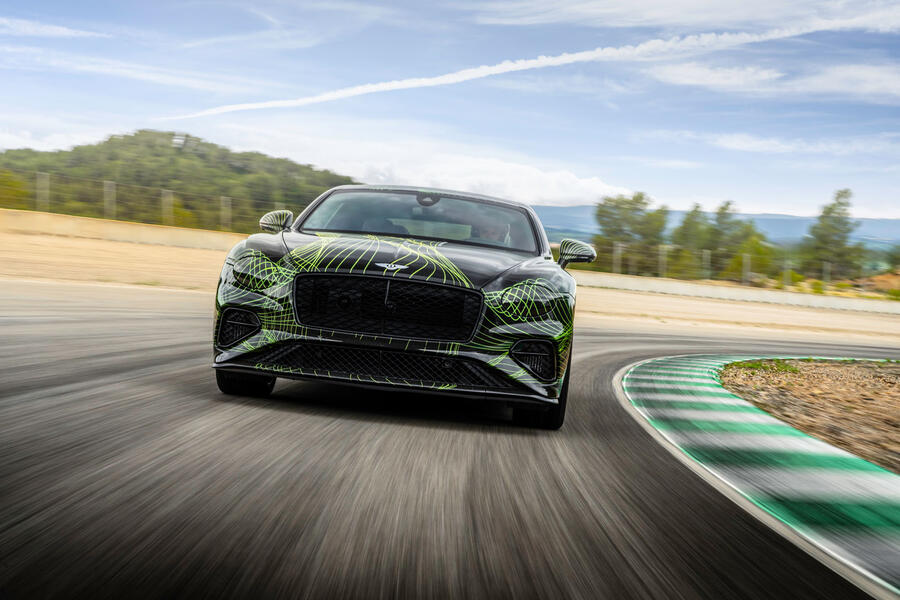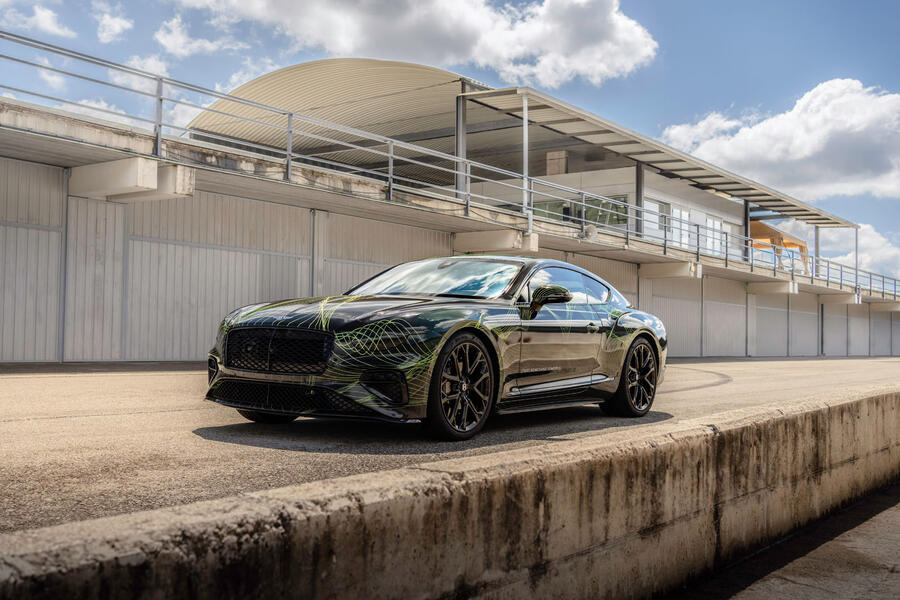A new-generation Bentley Continental GT gets a new-generation engine with mighty plug-in assistance
To replace the departing W12 engine in the Bentley Continental GT, the company is introducing a V8 plug-in hybrid powertrain. Badged Speed, it is the most powerful Bentley yet and is at the heart of this new-generation Continental, the fourth version of the company’s staple four-seat grand tourer since 2003. It rivals the Aston Martin DB12 and Ferrari Roma.
Combined, the 4.0-litre V8 and electric motor make a total of 771bhp and 738lb ft, or the car can drive on full electric alone (at 188bhp) for more than 50 miles. The powertrain drives all four wheels, heavily rear-biased, through an eight-speed dual-clutch automatic gearbox.
This late prototype is still wearing a disguise but there is some carry-over glass and metal from the existing Continental, and I had wondered whether that meant it was a mild tweak rather than a new-generation car, and therefore subject less testing and homologation.
Not so, says Bentley: the new powertrain, suspension, plus additional connectivity and cybersecurity regulations mean this is a new-generation model and the most tested and most regulated Continental GT yet.
Alone, the engine makes 591bhp (600 metric horses) at 6000rpm, so at 148bhp per litre, it’s blowing fairly hard, and even though peak torque comes in at 2000-4500rpm, the motor is partly there to boost torque and reduce lag at low revs. Depending on the drive mode, which we’ll come to in a moment, it’s also sometimes used to smooth gearchanges: the motor sits between the engine and the gearbox.

This front-engine, front-gearbox layout (some rivals have a transaxle instead) has given the Continental GT nose-biased handling previously and, although an active rear differential and torque vectoring (present here too) have greatly improved the balance over the years, it’s the adoption of a 25.9kWh battery mounted at the back that has finally brought the weight distribution to near 50:50.
Slightly concerningly, the overall weight has still to be confirmed, and we put the old W12 car on the scales at nearly 2.3 tonnes in 2018. But the battery has had the effect of reducing the fuel tank by 10 litres to 80 litres (the economy improvement, even if the car is used unplugged, prevents a reduction in the range) and raising the boot floor by a chunk (new capacity also tbc).
There is still heavy-duty hardware to manage the car’s heft. It has 48V active anti-roll bars, two-chamber air springs and a new dual-valve damper system that has a much broader spread of stiffness and response than previously.
The idea is that in the default B (for Bentley) driving mode, the car’s ride response is similar to the current car’s, but if you put it into a sporty mode, it becomes considerably better controlled than previously, and conversely is now much more comfortable in a softer setting. Crucially, so they say, the new set-up is better at isolation and body control, so you can have more of both.

My drive of it was limited to four laps of a damp circuit, and one of those was a cool-down lap, so most of that is to be confirmed at a later date. But two things stand out immediately: the steering is much lighter, and a bit more direct, which makes the car feel more alive and alert straight away; and the redistributed weight means its turn-in and balance feel much improved – more neutral on turn-in, and more adjustable on corner exit.
For what I think is the first time in a Continental GT, you can back it into corners on the brakes and feel the rear end start to work, to rotate, and then the car straightens its line really nicely on corner exit. I’m not sure what active rear steer – used to increase manoeuvrability at low speeds and enhance stability at higher ones – will be doing at this point but the whole thing feels quite natural. There’s some road feel through the steering too.
And it’s very fast. Bentley talks about a 0-62mph time of 3.2sec, and while it’s hard to get a feel for that on a damp circuit where power exceeds traction, there’s no let-up in pace and the V8 sounds very muscly. In the sportier drive mode, a gearshift kick is allowed; back off and select Comfort mode and shifts are much less perceptible.
As with the finished exterior, we can’t yet show you the inside, but I can tell you a big positive gearstick remains (it wouldn’t be necessary these days so they must like it), as does the rotating pyramid console element that displays either the touchscreen or a clock or nothing, depening on how switched-off you want to feel. That’s still central to the whole the idea of the Continental GT, they say: a car that can involve you if you want, but lets you sit back and waft if you don’t.
It's hard to discern how wafty it remains – initial impressions are that it is – but the involvement certainly feels turned up, in this very positive first acquaintance. More soon.



